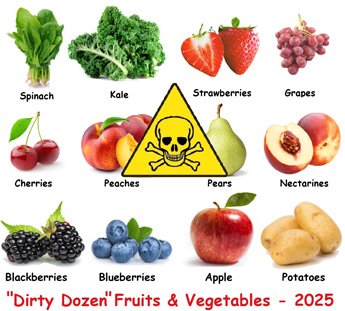Pesticide Contamination in Produce: What the EWG’s Findings Mean for Your Health
Pesticides and insecticides are chemical or biological agents used to protect crops from pests, diseases, and weeds. They help farmers maintain yields, reduce losses, and improve the quality of produce.
Studies have shown that a significant percentage of produce samples contain pesticide residues, with some exceeding maximum residue limits (MRLs).

A recent analysis examined pesticide residues in fruits and vegetables using liquid chromatography–tandem mass spectrometry and gas chromatography–mass spectrometry for dithiocarbamates. The findings revealed that 95.6% of samples contained multiple pesticide residues, highlighting the extent of contamination in commonly consumed produce. The most frequently detected pesticide classes included organophosphates (91.3%), carbamates (67.5%), pyrethroids (60.0%), dithiocarbamates (48.1%), and neonicotinoids (42.5%).
What Research Studies say –
Peer-reviewed scientific studies have shown that these residues may pose risks to human health, particularly when exposure occurs regularly over time. Consumers have a right to know not only the types but also the amounts of pesticides found on the foods they eat so they can weigh the benefits of fresh produce against potential harms.
Studies suggest that higher exposure to pesticide-laden produce may be associated with reduced fertility success rates, poorer embryo quality, and lower chances of live birth. Another study reveals men who ate produce with low pesticide residues had better sperm quality.
Studies suggest that pesticide residues can reduce the protective effects against cardiovascular disease and premature mortality that are typically linked with a diet rich in plant foods.
A large French population study conducted between 2014 and 2020 identified associations between certain mixtures of pesticides and an increased risk of breast cancer and Type 2 diabetes.
Scientists are particularly concerned about the “cocktail effect” of multiple pesticides. Even if individual chemicals are within legal limits, combined exposure to several different pesticides in a single diet may increase health risks in ways that are not yet fully understood.
Children are highly vulnerable to pesticide exposure, especially during pregnancy and early childhood. Such exposure can disrupt growth and development, increasing the risk of chronic health problems later in life.
2025 Dirty Dozen Produce list
Here’s the 2025 Dirty Dozen list, based on Environmental Working Group (EWG) most recent Shopper’s Guide to Pesticides in Produce, ranking conventionally-grown produce items with the highest pesticide residues:
-
Vegetables –
1Spinach, 2Kale, Collard & Mustard Greens, 3Potatoes (new addition)
-
Fruits –
4Strawberries, 5Grapes, 6Peaches,
7Cherries, 8Nectarines, 9Pears,
10Apples, 11Blackberries (new addition), and 12Blueberries.
Key note
For these reasons, the EWG recommends that consumers choose organic options for produce items that are known to have high pesticide residues. Washing, peeling, and cooking can reduce pesticide levels, but they do not eliminate all residues.
By prioritizing low-pesticide or organic produce, consumers can reduce their exposure to potentially harmful chemicals without sacrificing the nutritional benefits of fruits and vegetables.
Medical Disclaimer.
Read further on:
≺≺ EWG’s- The Clean Fifteen: Fruits and Vegetables with the Lowest Pesticide Levels.
≺≺ What are antioxidants? How antioxidants in the fruits and vegetables help in preventing cancers and diseases?
≺≺ What foods should people with high blood pressure avoid?
≺≺ How can I reduce the risk of cancer-causing chemicals when cooking or grilling meat?
≺≺ How toxic are the nitrites used in curing processed meats?
≺≺ What are the worst meats for accumulating cancer-causing chemicals during cooking?
≺≺ How are artificial sweeteners made?
≺≺ Can Physical Activity Help Improve My Arthritis?
≺≺ How common is thumb pain from too much texting?
≺≺ What health problems are linked to consuming corn syrup?
≺≺ What happens to my blood vessels when I gain weight?
≺≺ What are the four enemies of blood sugar?
≺≺ What type of exercise is best for lowering my blood sugar?
≺≺ What impact can sitting for long periods have on my health?
≺≺ Does my social circle impact my weight?
≺≺ How toxic are the nitrites used in curing processed meats?
≺≺ What foods can lower prostate cancer risk?
≻≻ Watch this page for more such informative articles on Health, Nutrition, and Wellness.
≻≻-Back to Home page.
Further reading (External Links opens in new window):
≺≺- -By EWG Science Team- EWG’s 2025 Shopper’s Guide to Pesticides in Produce.
≺≺- -By EWG Science Team- Pesticide exposure linked to brain activity differences in adolescents, study finds.